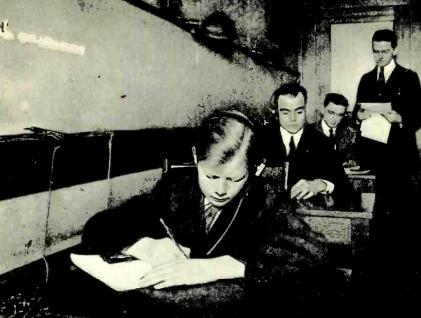The April 1926 issue of Popular Radio contains an interesting article detailing the requirements to get an amateur radio license 90 years ago. Written by prolific author Howard S. Pyle, 7HP, W7ASL, and W7OE, the article notes that examinations were given at the various radio inspection offices on a regular schedule. In Detroit, for example, Amateur exams were given on Saturdays starting at 10:00 AM, “and it is wise to appear promptly at this time, for the examining officer dislikes to be compelled to run the code test again for late comers.” It also explains that for those living in outlying areas, a temporary permit could be issued based upon a questionnaire and sworn affidavit of code ability, to be followed up by a personal examination at a later date.
The code test was originally set at “an arbitrary speed of five words a minute, … but experience proved it to be too slow.” Therefore, the speed as of 1926 was 10 words per minute, meaning 50 characters per minute. “An applicant is really offered five opportunities to demonstrate his ability,” since a single minute of solid copy was all that was required. “It is assumed, however, that he will put down a reasonable portion of the balance, in addition to the required number.”
Until a few years earlier, no sending test had been required. But “large numbers of operators, notably at sea, were later found, on observation, to have extremely poor ‘fists’ as their sending hand and style is termed in radio phraseology,” including the “Lake Erie Swing.” Therefore, a sending test was also required.
The code test out of the way, the applicant was then tested on his knowledge of radio theory. This test was based not upon a transmitter “you’ve seen on a steamer or in a broadcast station, but the one that is actually on your own operating table.”
Therefore, the first part of the test was to prepare a complete diagram of the transmitter, receiver, and source of power. “This must be complete in every sense of the word.” Then, the applicant was to explain to the inspector how it worked.
This does not mean that you are to say, “I throw my antenna switch to the transmitting position; cut in my power and work my key.” What is wanted is something like this:
“Using the alternating current of the house lighting circuits, through the medium of a setp-down transformer, the filament of the vacuum-tube oscillator is brought to incandescence, thus emitting an electron stream, which is caused to flow to the plate by reason…”
The remainder of the exam consisted of showing similar familiarity with the radio laws, operating procedures, Q signals, and other items deemed important by the examiner.
Pyle concludes:
Let the aspiring applicants to the “blue ticket” of the full-fledged amateur be encouraged and may the great fraternity remain foremost among the country’s youthful experimenters!
Click Here For Today’s Ripley’s Believe It Or Not Cartoon
![]()

